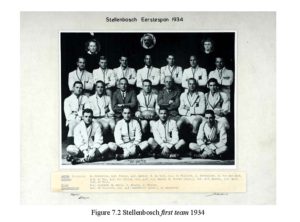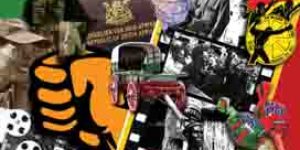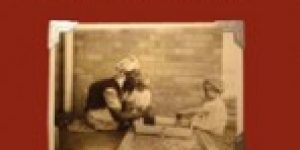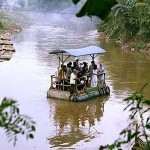Reshaping Remembrance ~ Rugby
No Comments yet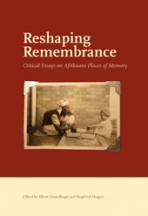 1.
1.
Only very few Afrikaner males have not been confronted with rugby at school, in some way or another. Interest in this sport is often carried over from father to son and it is particularly in this intimate process of transfer that commonalities are shared and that the game acquires one of its remembrance characteristics. This, however, is only one aspect of a much more dynamic and broader process that some commentators describe with a degree of irony as an elevated transcendental experience. Johann Symington, director of communication in the Dutch Reformed Church, describes rugby as far more than merely a national sport:
It is rather more like a religion with its own pantheon of gods and sacred traditions. It is true that players do not kneel or pray in the passageways of the stadiums, but the absolute dedication to the game and the team, the symbolic changing of clothing and the face painted to look like totem figures reveals something of the immanent religious status of the sport.[i]
In an extreme identification in 1970, Gert Yssel, a teacher and lay preacher in the then Western Transvaal, made the bizarre statement that God made the Springboks lose a test because young women in South Africa, according to him, wore indecent mini-dresses.[ii] Yssel’s logic with regard to cause and effect may have been suspect, but there can be no doubt about the central place that rugby occupied in his world as well as in his philosophy of life.
In the greater Afrikaner circles, the genealogy of the game goes beyond one or two generations and has a bearing on the identification of particular historical emotional values. At the time of the 75th anniversary of the South African Rugby Board, the renowned rugby administrator Danie Craven revealed something of the depth and intensity of the game’s remembrance matter in his official message. It was a ‘festive occasion’ of the game that ‘belonged to everyone’ and although there had been troubled times through the years, these had only strengthened rugby supporters so that they could enjoy the good times together. It had ‘bound them together historically’ as nothing else had ever done, and had created a feeling of ‘belonging’ that few people had the good fortune to enjoy.[iii]
To understand the remembrance dimensions of this sport, one needs to take note of the way in which rugby became popular with Afrikaners. The role of the University of Stellenbosch is in this regard one of the keys to understanding the connection. Since the late nineteenth century generations of young Afrikaner males turned to the ‘people’s university’ and it was within the context of the ‘people’ that the sons of the elite could revel in the game. When a number of young men in a state of hormonal aggression gathered within a demarcated space, the ideal breeding ground was created for a game such as rugby. But the game also formed part of the broader Afrikaner culture.
According to one observer, the manner in which ’students could convert their games and fun to a resounding cultural deed’ was the outstanding characteristic of student life in Stellenbosch in the 1930s and 1940s. At the time of the emergence of Afrikaner nationalism, rugby was just as much part of Afrikaner culture as boeremusiek, volkspele and the 1938 commemoration of the Groot Trek.[iv] The sport became part of a grouping of symbols that were closely interwoven with the emergence of Afrikanerdom. During this time the game became firmly established and, as more students graduated from Stellenbosch, the pool of memory associated with rugby became greater. It formed a vibrant subculture of robust masculinity that was often intent on warding off more threatening world views. Van Zyl Slabbert, himself a rugby player, and parliamentary leader of the white opposition in the mid-1980s, graphically described his aversion to the kind of subculture that came to the fore, particularly during rugby tours in the 1960s:
… the post-mortems after the game with pot-bellied, beer-drinking ‘experts’ from way back; the sight of players continually ingratiating themselves with sporting correspondents for some coverage; the pseudo-patriotic ethos that pervaded discussions on the importance of rugby in our national life; seeing successful farmers grovelling at the feet of arrogant second year students simply because we were ‘Maties’ on tour in their vicinity. Mentally it was not only escapist; it was a social narcotic to anything else going on in our society.[v]
The annual rugby tour of the university contributed to the memories associated with the game. It did not only bring the countryside into contact with the university and in so doing strengthened the bonds, but it also provided the tour groups with remembrance matter (mainly student antics) that would remain part of them for many more years. Tours abroad undertaken by national teams were similarly the source of future memories. For instance, during the much talked-of Springbok tour of New Zealand in 1956, many a father and son sat anxiously huddled together amid the static crackling of the radio, trying hard to hear how South Africa was faring on the muddy rugby fields of New Zealand. In the era before television, rugby tests were covered in detail in the press and the background and qualities of each player were fully spelled out. During the 1970 tour of the All Blacks, Chris Laidlaw, a member of the team, summed it up in the following way:
[T]he All Blacks were pictured, pestered, pondered, prodded and praised until every man, woman and child knew that this player ate eggs for breakfast, that one ate spinach, this lock-forward visited the toilet twice a day and that one twenty times.[vi]
Some of the players became household names and would still conjure up associations many years after the tour. A local player who stands out in this regard is Mannetjies Roux. A Springbok centre in the 1962 series against the British Lions, he scored a remarkable solo try in one of the tests. It was a try that was to become engraved into the collective memory as an iconic moment. In a certain sense, this deed echoed further than the stadium insofar as this moment reflected a greater dimension of supposed successful Afrikanerdom in the sixties in its full, triumphant glory: the economy showed unprecedented growth, the African National Congress and other organisations had been banned, the National Party was firmly in power and to crown it all the British came off second best on the rugby field because of a brilliant try by a player called Mannetjies. The press of the day described the try in almost euphoric terms: ‘While a host of defenders laid scattered in his wake or stood about with lowered heads, Roux – without a finger being laid on him – soared over the goal-line’.[vii] Years later the singer Laurika Rauch immortalised this moment through her nostalgic song in which she asks, ‘Do you still remember the try of Mannetjies Roux?’ (‘Onthou jy nog die drie van Mannetjies Roux?’)
It was not only with his performance on the rugby field that Roux etched himself deeply into the Afrikaner memory. During the 1969-1970 tour to Great Britain, which was characterised by unremitting anti-apartheid demonstrations, Roux unceremoniously kicked a demonstrator in the pants when he ran onto the field. In South Africa, uninformed and politically insensitive white rugby supporters, incited by the utterances of the well-known Afrikaans rugby commentator Gerhard Viviers (the ‘voice of rugby’) that the demonstrators were nothing less than ‘pink sewer rats’, welcomed the impulsive deed vociferously as appropriate behaviour against demonstrators.[viii] Mannetjies’s status rose by quite a few notches. In the long run, his remembrance capital has reached so far that a museum has even been devoted to him in Victoria West, where he runs a farm. Moreover, his fame helped him to gain financial assistance from the rugby fraternity when he ran into financial difficulties.
Rugby as a place of remembrance carries a mainly masculine dimension. Women are inclined to feature within a stereotypical form. In this regard, Danie Craven for instance held the viewpoint that women ‘should be gentle, gentle by nature, and also of gentle speech. If they are not gentle, they have no influence over men.’[ix] Otherwise women are merely the objects of male jokes at the braai after rugby.[x] Although women were undoubtedly heartily welcomed at rugby games, and while some of them are / were enthusiastic supporters, as far as remembrance matter is concerned, they are mainly accepted on male terms and it would certainly be unusual if a woman were to come forward in a prominent and positive role in the general discourse.
2.
Important rugby matches provided the stimulus for people to recall highlights from the past. Three years before the 1995 World Cup, rugby was associated more pertinently to nostalgia that reached out openly to a former dispensation. On 15 August 1992, after years of isolation, South Africa played against their rugby arch-enemy New Zealand once more. The game took place in a politically laden atmosphere in the wake of the Boipataung incident on the Witwatersrand in which various members of the ANC lost their lives. The ANC agreed to the game after deliberations with the Rugby Union, but expected that there would be a minute of silence for the victims before the kick-off and that the existing orange, white and blue flag would not be hoisted. The spectators, however, had other ideas and waved their flags while in a moment of disrespectful opposition they heartily sang Die Stem instead of observing the moment of silence.[xi] For them, it was not the time to embrace the ‘new’, but to recall to memory their rapidly fading political power.
However, three years later, with the African National Congress in power after the epoch-making elections of 1994, a remarkable change came about as well as a seemingly greater willingness to accept change. With the rugby world cup on their doorstep in 1995, after years of isolation, it began to look like if Afrikaners had exchanged politics for rugby and considered this as a very beneficial transaction. Very few rugby-related events have ever generated as many memories as the World Cup victory on 24 June 1995. The ‘new’ South Africa was officially not even a year old. When President Nelson Mandela appeared on the field in a replica number six jersey of the captain, Francois Pienaar, it appeared as if a divided country could at least symbolically be united – around a ball – on the rugby field. Exuberant celebrations followed and one of the characteristics of this situation was the reciprocal benevolence between white and black. ‘It was one of those days of which you could tell your grandchildren’, a journalist still remembered twelve years after the event, ‘how two warriors in their number six jerseys held the world cup aloft in view of 43 million South Africans. It will always give you goose-lesh.’[xii] The reasons for this ecstasy were complex and had more to do with the context of the time than with real nation building,[xiii] but the basis for a lasting memory had nonetheless been laid. Although rugby issues have since become more complicated and in some cases increasingly distasteful, the events of 24 June 1995 still remain a nostalgic marker. ‘I will never forget it,’ the singer Amanda Strydom said in 2007. ‘That moment when Madiba held the cup and the crowds went wild, we had hope for our country once more.’[xiv]
3
Part of the remembrance potential of rugby is situated in the identification of the spectators with the players through ‘honouring’ them with nicknames. In this manner a deepening of the association takes place and the possibility of remembering the player or players increases. For instance, a great number of the players who played for the Northern Transvaal from 1938 to 1988 had nicknames.[xv] Many of these nicknames also had a rural connotation: ‘Jakkals’ (‘Fox’) Keevy, ‘Hasie’ (‘Little Rabbit’) Versfeldt, ‘Koei’ (‘Cow’) Brink, ‘Padda’ (‘Frog’) Melville, ‘Wa’ (‘Wagon’) Lamprecht, ‘Boon’ (‘Bean’) Rautenbach and ‘Appels’ (‘Apples’) Odendaal, to name a few.[xvi] The nature of these nicknames reflects many Afrikaners’ rural background that is tied to the past in a particular rugby culture through a memory-related reference. Rugby stadiums also contribute to the process of remembrance creation. Johan Symington is of the opinion that rugby stadiums could possibly replace ‘ecclesiastical shrines’ as the dominant arena of momentous experiences: ‘[T]he stadium becomes the symbolically indomitable universe where titanic battles are fought, according to agreement and ritual’.[xvii] Particularly Loftus Versfeld in Pretoria and Newlands in Cape Town have such an almost mythical status. The stadium provides the externally visible concrete structures within which the mental structures regarding the game, together with the role of the media and peer groups, find a final expression and are strengthened in a ritualistic manner Saturday upon Saturday. The identification with the team also entails identification with the place where the team accomplishes its great deeds. It is argued that by playing a game at home in a familiar stadium, the home team is already given a certain advantage. With regard to Loftus Versfeld, there is also in the popular rugby culture the myth of a ‘Loftus Ghost’, which supposedly makes things more difficult for visiting teams.[xviii] When such transcendental qualities are linked to a stadium, the association with the game is enhanced, and the association with the game and the place is therefore established in the remembrance banks of the devotees.
It would be incorrect to link rugby memories only to the way in which whites experienced the game. In their resistance to apartheid, the activists created their own rugby culture, with amongst others the slogan ‘No normal sport in an abnormal society.’ Among such groups, a lasting tradition of ‘struggle’ rugby came into being. Although they did not have the luxury of immense and comfortable stadiums with green playingfields, their more modest sport facilities did not necessarily dampen their interest in the game. Today, in a professional era in which matters are conducted more clinically, signs of nostalgia can be detected among earlier anti-apartheid sport activists for the camaraderie that was forged in difficult circumstances.[xix]
Since the presidency of Thabo Mbeki in particular there has been increasing pressure for South African rugby to conform to the guidelines of the African National Congress for change in sport. ‘Transformation’ appears to be a drawn-out process, especially because it essentially centres on the ownership of the game. Ownership naturally has many dimensions, but one of them is the issue of cultural capital in the form of remembrance matter. Given the intensity and emotional depth of remembrance of rugby it is not surprising that the spiritual ownership of the game will probably be contested over a longer period of time.
NOTES
i. Die Burger, 23 May 2007.
ii. Sunday Times, 14 June 1970.
iii. Suid-Afrikaanse Rugbyraad, Rugby in Suid-Afrika. Cape Town: Johnston & Neville 1964, i.
iv. B. Booyens, ‘Studentelewe – die jongste tydperk’, in: H.B. Thom (ed.), Stellenbosch, 1866-1966: Honderd jaar hoër onderwys. Cape Town: Nasionale Boekhandel Beperk 1966, 394.
v. F. van Zyl Slabbert, The Last White Parliament. Johannesburg: Ball 1985, 20.
vi. C. Laidlaw, Mud in your Eye: A Worm’s Eye View of the Changing World of Rugby. Cape Town: Timmins 1974, 97-98.
vii. H. le Roux, Sportpourri: ervarings van ’n joernalis. Pretoria: Van Schaik 1998, 42.
viii. A. Grundlingh, S.B. Spies & A. Odendaal, Beyond the Tryline: Rugby and South African Society. Johannesburg: Ravan 1995, 126 (translated
ix. Grundlingh, Spies & Odendaal, 126 (Translatedl)
x. SA Rugby, December 1997, 62.
xi. A. Grundlingh, S.B. Spies & A. Odendaal, Beyond the Tryline: Rugby and South African Society. Johannesburg: Ravan 1995, 10-11.
xii. Die Burger, 8 September 2007.
xiii. This matter is discussed comprehensively in A. Grundlingh, ‘From redemption to recidivism? Rugby and change during the 1995 Rugby World Cup and its aftermath’, in: Sporting Traditions, 14, 2 May 1998.
xiv. Die Burger, 8 September 2007.
xv. M.C. van Zyl (ed.), Northern Transvaal rugby: 50. Pretoria: Perskor, 1988, 385-396.
xvi. A. Grundlingh, S.B. Spies & A. Odendaal, Beyond the Tryline: Rugby and South African Society. Johannesburg: Ravan 1995, 120.
xvii. Die Burger, 23 May 2007.
xviii. M.C. van Zyl (ed.), Northern Transvaal Rugby: 50. Pretoria: Perskor 1988, 97.
xix. A. Grundlingh, S.B. Spies & A. Odendaal, Beyond the Tryline: Rugby and South African Society. Johannesburg: Ravan 1995, 24-63; Die Burger, 28 August 2007.
References
Booyens, B. ‘Studentelewe – die jongste tydperk’, in: H.B. Thom (ed.). Stellenbosch, 1866- 1966: Honderd jaar hoër onderwys. Cape Town: Nasionale Boekhandel Beperk 1966.
Grundlingh, A. ‘From Redemption to Recidivism? Rugby and Change during the 1995 Rugby World Cup and its Aftermath’, in: Sporting Traditions, 14, 2 May 1998.
Grundlingh, A., Spies, S.B. & Odendaal, A. Beyond the Tryline: Rugby and South African Society. Johannesburg: Ravan 1995.
Laidlaw, C. Mud in your Eye: A Worm’s Eye View of the Changing World of Rugby. Cape Town: Timmins 1974.
Le Roux, H. Sportpourri: ervarings van ’n joernalis. Pretoria: Van Schaik 1998. ‘Mini-skirts and Rugby’. In: Sunday Times, 14 June 1970.
‘Onthou jy die dag?’ In: Die Burger, 8 September 2007.
‘Rugby ’n soort godsdiens met eie gode, heilige tradisies’. In: Die Burger, 23 May 2007.
‘Rugby in ’n ander gewaad.’ In: Die Burger, 28 August 2007.
Slabbert, F. van Zyl. The Last White Parliament. Johannesburg: Ball 1985.
You May Also Like
Comments
Leave a Reply

